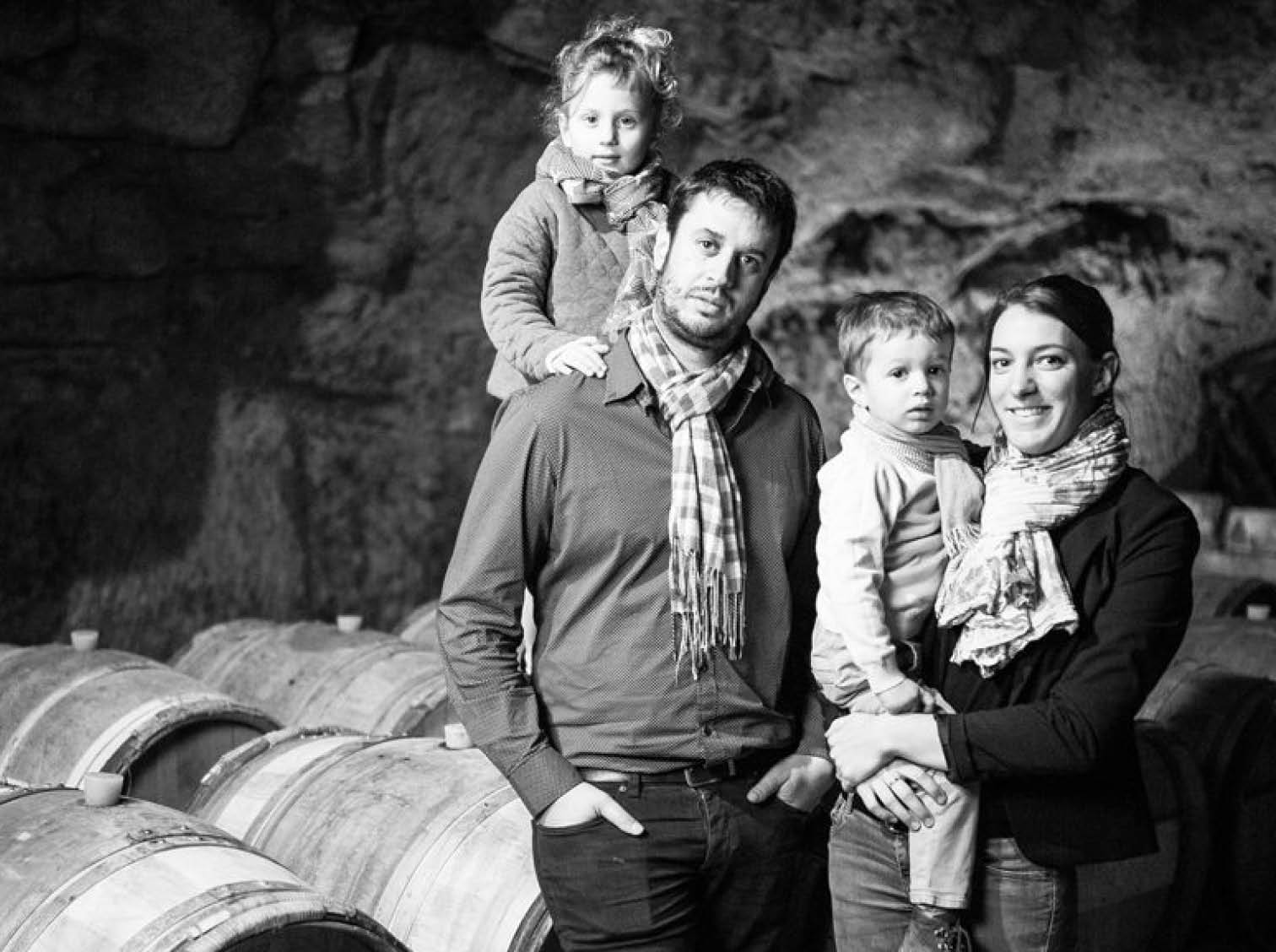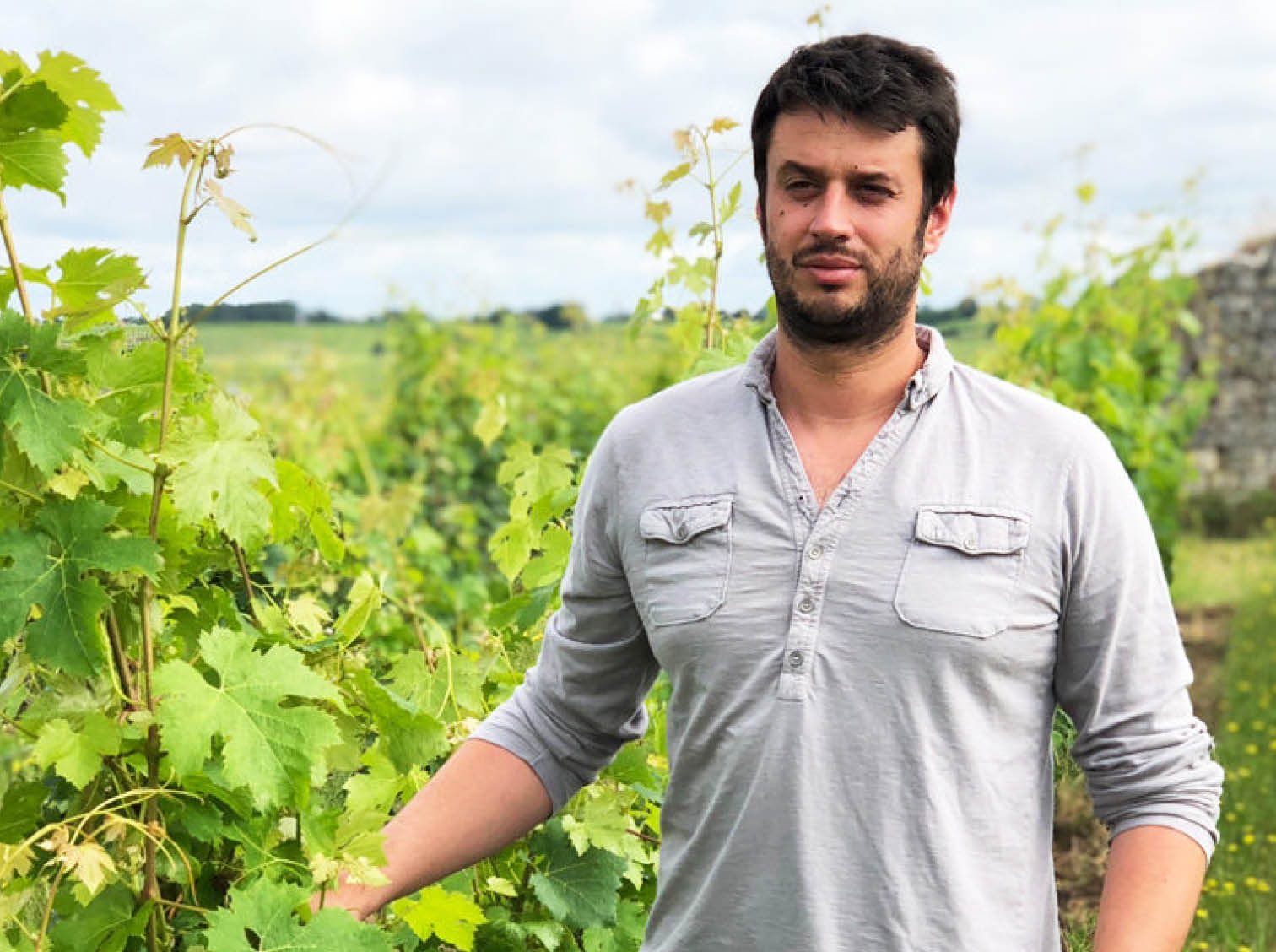FABIEN DUVEAU
About
Fabien Duveau makes his wines in a deep limestone cave dug in the 14th century from the same beautiful creamy white sandstone that later went to build the great Loire chateaux. His cellar is located in the narrow main street of Chacé, only a few doors from the Foucault house and cellars where for many years visitors came to taste Clos Rougeard wines. The caves were first used as dwellings for the Saumurois, though the constant chill and humidity levels they bring are more perfectly suited for winemaking and storage than human habitation. The domaine, in Fabien’s family since the late 18th century, now spreads over 16 hectares around the neighbouring villages of Saint-Cyr-en-Bourg, Varrains and Brézé.
The name Champigny derives from the Latin Campus Ignis (fields of fire), a reference to the relative heat of the microclimate, the warmest in Saumur. Crucial to the freshness of the wines is, Fabien notes, “the land’s ability to store this heat by day and diffuse it by night.” Being positioned at the eastern edge of the maritime zone tempers extreme heat during the growing season, though raises temperatures substantially in the winter. Protected from Atlantic moisture by the gently sloping hills to the west, Saumur-Champigny vineyards see some of the driest conditions in the region, with Saint-Cyr-en-Bourg the most arid.
Brézé lies just to the south of the border of Saumur Champigny and it notable not only for its UNESCO listed Chateau de Brézé, but also its gentle though notable hill of limestone covered in sand as distinct to the richer clay based top-soil more common around Saint-Cyr-en-Bourg (which also shares the same limestone tuffeau deeper down). A low plateau of tuffeau, the yellow-white calcareous rock so distinctive of the central Loire, rises at the eastern edge of the town of Saumur and continues southeast, running under Fabien’s holdings. Tuffeau retains water as other limestones do, and drains more effectively, protecting against hydric stress while releasing water to the vines as needed. Overlaying the tuffeau is a mix of sand clay and limestone.
For winemaking all wines are fermented with native yeast and his reds are 100 % destemmed and whites whole bunch pressed. No SO2 is used in the elevage until bottling with minimal safe levels. Fabien attributes the fine velvety tannins, vivid fruit, and appetising freshness of his Cab Francs and the forceful intensity of his Chenins to this soil composition. His aim is to allow the personality of each parcel to come through clearly in his wines. To this end he emraced organic and then bio-dynamic practices in the vineyards to enable each plot to fully express itself.
At about the time Fabien converted the family holdings to organics, Saumur-Champigny growers were banding together to establish Ecological Zone Reservoirs (EZR) — border areas of bushes, trees, and creepers, designed to provide year-round shelter, food, and breeding sites for helpful insects, birds, and animals. “Proximity to the plot encourages exchanges between the EZR and the vine. Grasses around the plot and the presence of vegetation between the rows accentuate these exchanges,” Fabien explains.
In the vineyards, Fabien has a mix of clones, though his oldest plots (mostly planted in 1960’s) are of massale selections. All training is guyot and yields are carefully controlled. Fabien vinifies and bottles separately his holdings in Les Hautes (upper) and Les Bas (lower) Poyeux. (Clos Rougeard made this site famous, and have only ever bottled as just Poyeux - and only in Cabernet Franc.) Fabien makes a distinction based on vine age (older vines in Bas Poyeux), soil composition, elevation, and orientation, which leads him to take a different course in the cellar as well.
Les Hauts Poyeux sports the famous Poyeux sand, which runs to a depth of 80 cm before the first clay over limestone. Fabien gives this wine a long maceration, or as he says, ‘essentially an infusion’ allowing the aromatics to be linked to this soil texture. Aging for 12 to 18 months further refines the aromatics and shows the finesse of tannins in this amazing terroir.
Bas Poyeux is lower, with shallow (20 cm) sandy soils over clay and limestone. This gives the limestone an opportunity to shine through. Fabien uses half concrete vats and half barrels for the ageing to show out the depth and complexity of this site.
The richness of this terroir is also expressed in the Duveau chenin. He’s also the only producer we know of that releases a Chenin from Poyeux, from his tiny holding of 0.8 ha. And it’s from 40+ year-old vines to boot. The successive soil layers (sand, clay, limestone) give the white Poyeuxits seamless elegance, finesse and minerality. An outstanding Chenin by any measure.
2023 Saumur Blanc ‘La Hunardiere’

Grape variety: 100 % Chenin
Terroir: Alteration of calcareous sands on tufa or green chalk rock.
Vineyard Managment
The soil is worked in its entirety, with respect for the environment and the plant, in Organic Agriculture. The grassing is natural. The biodynamic approach (certification in progress) allows us to be as close as possible to the terroir with the constant search for balance between the vine and its environment.
Vinification
Manual harvesting, slow pressing and traditional vinification carried out with respect for the grapes, without the addition of sulfite. Fermentation with indigenous yeasts in our underground cellars. Maturation for about 6 months in concrete tanks and barrels.
Tasting
To be served around 10°C
On the nose, La Hunaudière reveals notes of yellow apple, tangerine and peach. On the palate, the wine is supple, fresh and aromatic.
2023 Saumur Blanc ‘Chace Les Poyeux’

Grape variety: 100 % Chenin
Terroir: Sand to clayey sand at depth with occasional sandstone pebbles.
Vineyard Managment
Vines planted in 1976 The soil is worked in its entirety, with respect for the environment and the plant, in Organic Agriculture. The biodynamic approach (certification in progress) allows us to be as close as possible to the terroir with the constant search for balance between the vine and its environment.
Vinification
Manual harvesting, slow pressing and vinification carried out in the respect of the grape, without addition of sulfite. Fermentation with indigenous yeasts, in barrels of different ages, in the heart of our underground cellars. Aged for 12 months in barrels.
Tasting
To be serve around 12°
Les Poyeux has a fresh nose of white flowers and citrus fruit. On the palate, after a fresh attack, we find aromas of white fruits such as apple and pear, accompanied by a beautiful minerality that gives the wine its length.
2022 Saumur Breze Blanc ‘Le Bois du Chene’

Grape variety: 100 % Chenin
Terroir: Sandy-loam chalk
Vineyard Managment
Vines planted in 1960. The soil is worked in its entirety, with respect for the environment and the plant, in Organic Agriculture. Grass cover is natural. The biodynamic approach (certification in progress) enables us to be as close as possible to the terroir, with a constant search for balance between the vine and its environment.
Vinification
Hand-harvested, slow-pressed and vinified with respect for the grapes, without the addition of sulfites. Fermented with indigenous yeasts in new barrels in our underground cellars. Aged for around 18 months in barrels.
Tasting
Served around 14°C
Bois du chêne opens with a fruity, floral nose. On the palate, it develops a complex structure with a fresh attack followed by a beautiful minerality. Slowly, this cuvée reveals itself to be round and fruity, with a long vanilla finish.
2022 Saumur Champigny ‘Les Menais’

Grape variety: 100 % Cabernet Franc
Terroir: Sand on limestone formation
Vineyard Managment
Vines averaging 30 years old.
The soil is worked in its entirety, with respect for the environment and the plant, in Organic Agriculture. Grass cover is natural. The biodynamic approach (certification in progress) enables us to be as close as possible to the terroir, with a constant search for balance between the vine and its environment.
Vinification
Hand-harvested, hand-sorted in the winery. Fermentation with indigenous yeasts, short maceration and traditional vinification without the addition of sulfite. Aged for approximately 6 months in concrete tanks.
Tasting
Served around 16°C
The nose reveals a bouquet of black fruits, with a predominance of blackberry and blueberry. The attack is supple and fresh, with raspberry and cherry aromas and the minerality typical of the terroir. The length is marked by pepper.
2023 Saumur Champigny ‘Bourg’

Grape variety: 100 % Cabernet Franc
Terroir: Alteration of sandy-loamy green chalk
Vineyard Managment
Vineyard planted in 1966.
The soil is worked in its entirety, with respect for the environment and the plant, in Organic Agriculture. Natural grass cover. The biodynamic approach (certification in progress) enables us to be as close as possible to the terroir, with a constant search for balance between the vine and its environment.
Vinification
Hand-harvested, selectively sorted in the winery. Fermentation with indigenous yeasts, traditional vinification without the addition of sulfites, then aged for around 10 months in concrete vats.
Tasting
Serve around 18°C
Le Bourg opens with jammy red fruit aromas that are present from the outset, accompanied by a clean structure. Minerality and peppery tannins mark the length.
2022 Saumur Champigny ‘Les Bas Poyeux’

Grape variety: 100 % Cabernet Franc
Terroir: Sandy – silty chalk on green chalk rock
Vineyard Managment
Vines planted in 1960.
The soil is worked in its entirety, with respect for the environment and the plant, using organic farming methods. Natural grass cover. The biodynamic approach (certification in progress) enables us to be as close as possible to the terroir, with a constant search for balance between the vine and its environment.
Vinification
Hand-harvested, hand-sorted in the winery. Fermentation with indigenous yeasts, traditional vinification without the addition of sulfites, then aged for around 10 months in concrete vats and barrels.
Tasting
Serve at around 18°C
The bewitching nose expresses ripe, fresh Cabernet, with notes of cherry blackcurrant and redcurrant. The concentrated, juicy, precise flesh lacks neither elegance nor depth, supported by great minerality and magical purity.
2022 Saumur Champigny ‘Les Hauts Poyeux’

Grape variety: 100 % Cabernet Franc
Terroir: Alterations of calcareous sands with a falunaceous appearance on tufa rock
Vineyard Managment
Vines planted in 1980
The soil is worked in its entirety, with respect for the environment and the plant, in Organic Agriculture. Grass cover is natural. The biodynamic approach (certification in progress) allows us to be as close as possible to the terroir, with a constant search for balance between the vine and its environment.
Vinification
Hand-harvested, hand-sorted in the winery and vinified without the addition of sulfite. Fermentation with indigenous yeasts, traditional vinification, then ageing for around 12 months in barrels.
Tasting
Serve at around 18°C
Smoky nose with a touch of red fruit, firm tannins, slightly heavy ageing, but the fruit takes over, complex finish.
 (Image: Fabien Duveau | www.schatziwines.com)
(Image: Fabien Duveau | www.schatziwines.com)
New release enquiry


